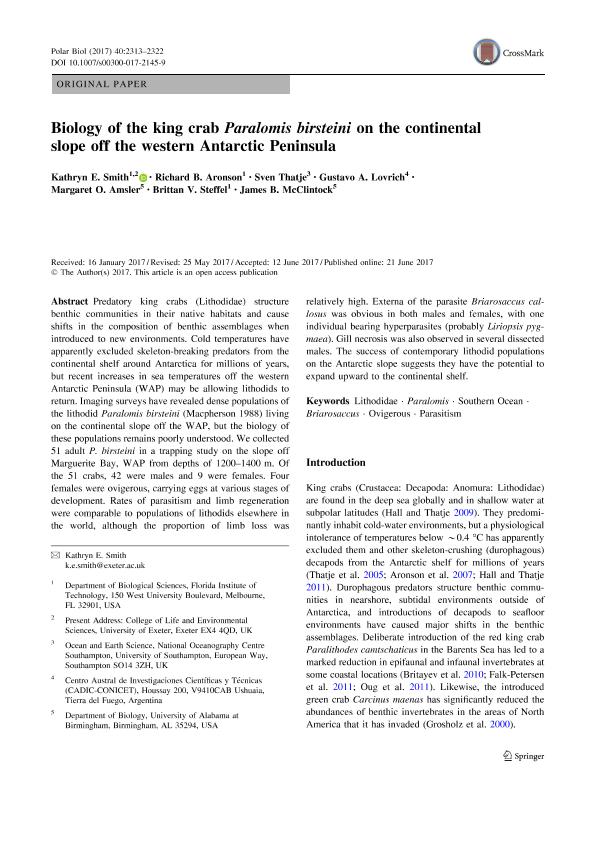Mostrar el registro sencillo del ítem
dc.contributor.author
Smith, Kathryn E.
dc.contributor.author
Aronson, Richard B.
dc.contributor.author
Thatje, Sven
dc.contributor.author
Lovrich, Gustavo Alejandro

dc.contributor.author
Amsler, Margaret O.
dc.contributor.author
Steffel, Brittan V.
dc.contributor.author
McClintock, James B.
dc.date.available
2020-01-14T20:05:55Z
dc.date.issued
2017-11
dc.identifier.citation
Smith, Kathryn E.; Aronson, Richard B.; Thatje, Sven; Lovrich, Gustavo Alejandro; Amsler, Margaret O.; et al.; Biology of the king crab Paralomis birsteini on the continental slope off the western Antarctic Peninsula; Springer; Polar Biology; 40; 11; 11-2017; 2313-2322
dc.identifier.issn
0722-4060
dc.identifier.uri
http://hdl.handle.net/11336/94678
dc.description.abstract
Predatory king crabs (Lithodidae) structure benthic communities in their native habitats and cause shifts in the composition of benthic assemblages when introduced to new environments. Cold temperatures have apparently excluded skeleton-breaking predators from the continental shelf around Antarctica for millions of years, but recent increases in sea temperatures off the western Antarctic Peninsula (WAP) may be allowing lithodids to return. Imaging surveys have revealed dense populations of the lithodid Paralomis birsteini (Macpherson 1988) living on the continental slope off the WAP, but the biology of these populations remains poorly understood. We collected 51 adult P. birsteini in a trapping study on the slope off Marguerite Bay, WAP from depths of 1200–1400 m. Of the 51 crabs, 42 were males and 9 were females. Four females were ovigerous, carrying eggs at various stages of development. Rates of parasitism and limb regeneration were comparable to populations of lithodids elsewhere in the world, although the proportion of limb loss was relatively high. Externa of the parasite Briarosaccus callosus was obvious in both males and females, with one individual bearing hyperparasites (probably Liriopsis pygmaea). Gill necrosis was also observed in several dissected males. The success of contemporary lithodid populations on the Antarctic slope suggests they have the potential to expand upward to the continental shelf.
dc.format
application/pdf
dc.language.iso
eng
dc.publisher
Springer

dc.rights
info:eu-repo/semantics/openAccess
dc.rights.uri
https://creativecommons.org/licenses/by-nc-sa/2.5/ar/
dc.subject
BRIAROSACCUS
dc.subject
LITHODIDAE
dc.subject
OVIGEROUS
dc.subject
PARALOMIS
dc.subject
PARASITISM
dc.subject
SOUTHERN OCEAN
dc.subject.classification
Biología Marina, Limnología

dc.subject.classification
Ciencias Biológicas

dc.subject.classification
CIENCIAS NATURALES Y EXACTAS

dc.title
Biology of the king crab Paralomis birsteini on the continental slope off the western Antarctic Peninsula
dc.type
info:eu-repo/semantics/article
dc.type
info:ar-repo/semantics/artículo
dc.type
info:eu-repo/semantics/publishedVersion
dc.date.updated
2020-01-13T14:19:34Z
dc.journal.volume
40
dc.journal.number
11
dc.journal.pagination
2313-2322
dc.journal.pais
Alemania

dc.journal.ciudad
Berlin
dc.description.fil
Fil: Smith, Kathryn E.. University of Exeter; Reino Unido. Florida Institute Of Technology; Estados Unidos
dc.description.fil
Fil: Aronson, Richard B.. Florida Institute Of Technology; Estados Unidos
dc.description.fil
Fil: Thatje, Sven. University of Southampton; Reino Unido
dc.description.fil
Fil: Lovrich, Gustavo Alejandro. Consejo Nacional de Investigaciones Científicas y Técnicas. Centro Austral de Investigaciones Científicas; Argentina
dc.description.fil
Fil: Amsler, Margaret O.. University Of Alabama At Birmingham; Estados Unidos
dc.description.fil
Fil: Steffel, Brittan V.. Florida Institute Of Technology; Estados Unidos
dc.description.fil
Fil: McClintock, James B.. University Of Alabama At Birmingham; Estados Unidos
dc.journal.title
Polar Biology

dc.relation.alternativeid
info:eu-repo/semantics/altIdentifier/doi/http://dx.doi.org/10.1007/s00300-017-2145-9
dc.relation.alternativeid
info:eu-repo/semantics/altIdentifier/url/https://link.springer.com/article/10.1007%2Fs00300-017-2145-9
Archivos asociados
